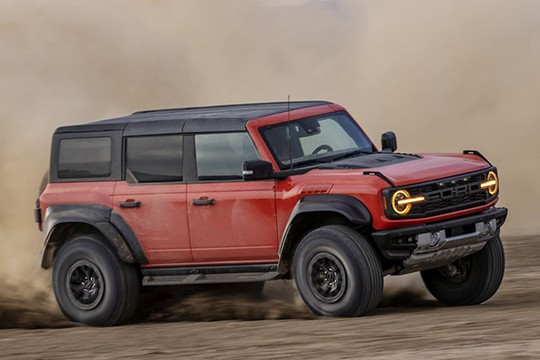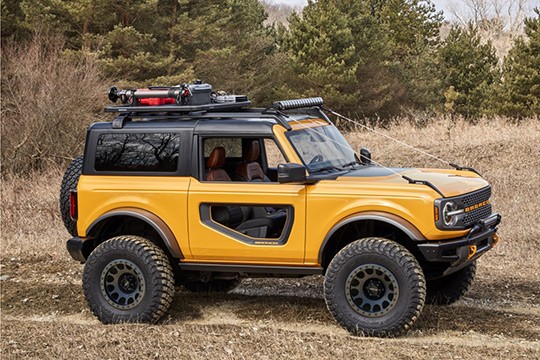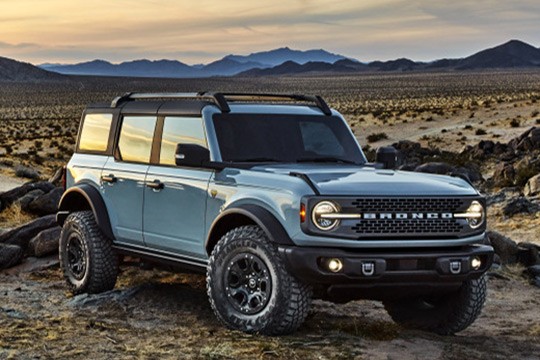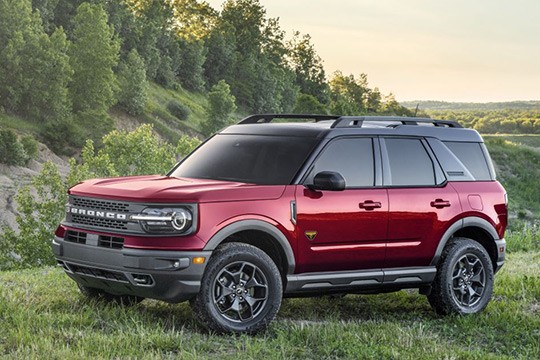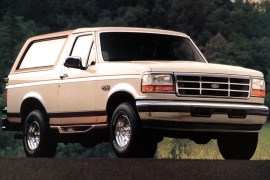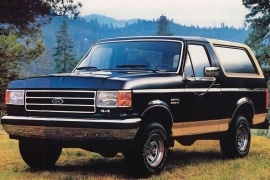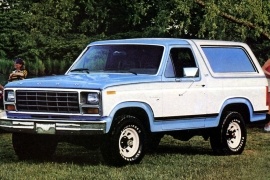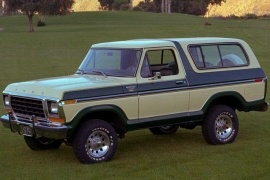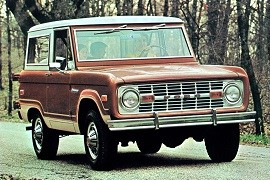FORD Bronco Models/Series Timeline, Specifications & Photos
First production year: 1966
Engines: Gasoline
Body style: SUV (Sports Utility Vehicle)
Ford made a bold move forward when it introduced the Raptor version for the 2022 Raptor and gave the car a much more powerful engine and a suspension setup that transformed the SUV into a fast off-road beast.
The American brand already had a Raptor lineup, and all of them were highly capable on trails. Thus, the Bronco had a promise to keep, and Ford ensured its customers that they won't be disappointed. For starters, it improved the car's image with beefier, 35" tires and a high-lift suspension. Its upgraded Dana heavy-duty axles, both front, and rear, led to a longer wheelbase, extended by 8.6 inches when compared to the rest of the Bronco range. In addition, a sturdy-looking aluminum shield installed under the front bumper protected the engine from hits and rocks, while the fenders received wider flares over the tires.
Inside, there were minimal upgrades in terms of design, but a keen eye for detail could notice the new ring that surrounded the GOAT (Goes Over All Terrain) all-wheel drive selector placed on the center console. In addition, Ford installed a standard touch-screen infotainment atop the center stack, in line with the instrument cluster, which was also digital. Finally, a few carbon-fiber trims adorned the steering wheel, with the Raptor badge written on the lower spoke.
Under the hood, the carmaker placed a new powerplant that offered more power and torque than the rest of the Bronco range. It was mated as standard to a ten-speed automatic transmission. Moreover, the transfer box was upgraded and offered a 3.06:1 gearing, made especially for rock crawling.
Just like the 1965 Bronco, Ford offered the new model with two or four doors. The two-door version featured a shorter wheelbase and a smaller cabin.
Ford designed the Bronco as a direct competitor for the Jeep Wrangler. The engineering team made the car handle better on the road and took care of what the off-road enthusiasts told them. While the four-door version was made more for a family that might go in the wild, the two-door version was built to conquer the wilderness.
From the outside, the round headlights and the flat grille resembled the image of the 1965 Bronco. The design team imagined a squared design for the car, with rounded corners. The doors and the roof were removable. They could have been stored in the trunk, leaving the car with a roll-cage from the A-pillars to the tailgate and cross members above the passenger area.
Inside, the Bronco featured a mix of digital display and analog dials for the instrument cluster. The design team installed an 8” touch screen display integrated into the dashboard, with an option for a 12” display. On the sides, the grab-handles were very useful for the other occupants to get in or out of the car. The interior was designed to be easy to wash, with rubber floor carpeting and special upholstery. On top of the dashboard, there were few buttons covered with rubber.
The Bronco featured a 2.3-liter turbocharged engine as standard. It was the only version available with a 7-speed manual transmission and a crawl-gear. As an option, the carmaker mated the base engine to a 10-speed automatic as well. The other option was a 2.7-liter that offered 310 hp and mated as standard to the automatic gearbox.
After years of begging, the Ford fans received the legend: the Bronco. An off-road vehicle built for severe off-roading, a car that brought back the smile on off-road enthusiasts.
Unlike its smaller brother Bronco Sport, Ford offered the Bronco with a choice of two or four doors. It was built as a tough off-road vehicle, with a front independent suspension and a five-link rear axle. The Bronco featured a rear differential lock fitted as standard while the front locking was offered as an option.
From the outside, the round headlights and the flat grille resembled the image of the 1965 Bronco. The design team imagined a squared design for the car, with rounded corners. The doors and the roof were removable. They could have been stored in the trunk, leaving the car with a roll-cage from the A-pillars to the tailgate and cross members above the passenger area.
Inside, the Bronco featured a mix of digital display and analog dials for the instrument cluster. The design team installed an 8” touch screen display integrated into the dashboard, with an option for a 12” display. On the sides, the grab-handles were very useful for the other occupants to get in or out of the car. The interior was designed to be easy to wash, with rubber floor carpeting and special upholstery. On top of the dashboard, there were few buttons covered with rubber.
The Bronco featured a 2.3-liter turbocharged engine as standard. It was the only version available with a 7-speed manual transmission and a crawl-gear. As an option, the carmaker mated the base engine to a 10-speed automatic as well. The other option was a 2.7-liter that offered 310 hp and mated as standard to the automatic gearbox.
After years of begging, the Ford fans received the legend: the Bronco. An off-road vehicle that was built for severe off-roading, a car that brought back the smile on off-road enthusiasts.
Ford introduced the original Bronco in 1965, and its design was the inspiration for the 2020 model. Some say that the new design team took an old vehicle and scanned it to the smallest details to understand it. Then, they went to the drawing board and made the best retro-look new off-road vehicle on the market.
The Bronco Sport was the smaller brother in the family, but with four doors. The front had a similar design, with a flat grille. A clear lens covered the round headlamps, and an LED daytime running light connected the headlight to the grille. Its lower side confirmed the rugged appearance, with rocker-sliders and a black and curved apron that looked like a shield. The designer team placed a small vent behind the front fenders. The roof had a small step over the rear seats, to make more headroom. It was an idea seen before on the Land Rover Discovery.
The Bronco had an SUV look with two analog dials and a TFT display for the instrument cluster. Ford offered the Bronco with an 8” touch-screen for the SYNC3 infotainment unit. It was compatible with Apple CarPlay and Android Auto. Numerous safety systems were included in the Ford Co-Pilot360 system, such as the Forward Collision Warning, the Lane Keep Assist, Dynamic Brake support, etc.
Unlike its bigger brother, Ford fitted the Bronco Sport with a choice of two EcoBoost engines that offered 181 hp and 245 hp, respectively. Both versions were mated to a standard 8-speed automatic transmission. The all-wheel-drive system was fitted as standard.
A true legend among the off-road passionate customers, the pure American Bronco was at its fifth generation when released in 1992. The first Bronco was offered to the public in 1966.
The old-school SUV was mostly designed for customer looking for proven reliability and durability.
The main competitors were the Chevy K Blazer and the Dodge RAM.
The Bronco was offered in 3 trim levels: base, XLT and the premium Eddie Bauer.
The exterior of the Bronco was blocky, but with improved aerodynamics by lowering the wind resistance, fact that also helped with a reduced wind noise inside the cabin.
The chromed front bumper protected the paint from scratches, as well as it happened at the back of the car with the chromed rear bumper.
The truck-based Bronco came with an optional 4-wheel-drive, a 5.0-liter V8 engine that developed 185 hp.
The engine was mated to a 5-speed manual transmission or an automatic transmission as an option.
The wheels were equipped with manual hub locks, used to lock to the differential when going off-road.
The back of the car was designed to come off and for that, 2 people would need to team up, as it was not the easiest thing to do.
Inside the Bronco we could find an easy viewing instrument panel and simple and practical features such as: A/C, AM/FM, power windows and door locks.
The blue-oval brand introduced the fourth generation of the Bronco in 1987 and kept it in production for just four years.
The 1987 Bronco was based on the same chassis as its predecessor. It was a shortened version for the F150 pickup-truck ladder-chassis, built for tough jobs and hard off-road situations. It was already known for its reliability, and the only thing that lacked was a touch of styling. The 1987 model fixed that, at least for four years.
The flush with the grille headlights and the smoother front end was part of the features that distinguished the fourth-generation Bronco from its predecessor. Some of its body panels were shared with the F150, which was still the best selling pickup truck in the world. An interesting feature for the car was the rear tailgate with a power-window. But it lacked a wiper and a washer.
Inside, things didn't change much over the years. But the instrument panel followed the trend of its years and its sedan-look layout was a better fit for a family vehicle than the one for a pickup-truck. The tachometer was an extra-cost option. The front seats were wide, but they lacked some movement. For instance, the passenger's seat was reclinable only. An unusual feature was the high-beam switch, which was placed on the floor!
The Bronco featured live axles both front and rear, and that was good for off-road situations, but it wasn't too comfortable on the road. Ford offered the Bronco with a choice of three engines ranged between a 4.9-liter inline-six and a 5.8-liter V8.
Ford spent $700 million in the downsizing program at the end of the '70s, and the Bronco received them to get better fuel efficiency and provide a more comfortable ride.
Looking at the third Bronco generation and comparing it to its predecessor wouldn't tell you where that money was gone. They seemed so similar that it might be considered just a facelift. Yet, it was a completely new vehicle that replaced another vehicle that lived just a couple of years on the market. But Ford was proud of the 1980 Bronco, like it was the best vehicle in its class. And it wasn't.
The third Bronco was still a body-on-frame vehicle built for rough off-road situations, but the carmaker enhanced its aerodynamic to lower the wind noise and improve the fuel-efficiency. But the flat front area with squared headlights and a fence-like grille didn't seem to be very aerodynamic. Its windshield was raked even more than on its predecessor, and that was truly an improvement.
Inside, the carmaker made a roomy interior, but it was noticeable that its designers burned the midnight oil to finish the car in time and overlooked the driver's visibility. Apart from the optional rear spare-wheel, there was the B-pillar that blocked the view. Once inside, though, everyone on-board could enjoy the bird-eye-view over the traffic.
The real improvement was on the front suspension, which received an independent system with coil springs. In the back, there was still the same axle carried over from the Ford F-150. The Bronco was available with two engine options, a transfer case and low-range gear, which helped the car handle really well in off-road situations.
When Ford introduced the second generation of the Bronco in 1978, it was a true revelation: it wasn't a utility truck used for agricultural needs anymore.
By the late '70s, Ford noticed an increasing demand for off-road cars used for leisure. The same vehicles were used as daily drivers, so they have to offer a certain comfort level. Last but not least, the vehicle's look had to be rugged.
Its wide stance, with slant nose and a bulge on the otherwise flat, hood offered a macho-look that created a big surprise on the market. Its squared headlights in individual, black casings, didn't look like e black-eye, but like a look that will get you one. Due to the chromed, metallic bumper, the designers enhanced the rugged look of the vehicle. Depending on the trim and options, an additional metallic crush-bar was available. The pickup look was enhanced with a bi-color hardtop that covered the rear seats and the small trunk from the profile.
Inside, the flat dashboard with squared dials continued the rugged exterior look. Its bucket-seats were covered with a mix of fabric and vinyl upholstery. While the carmaker placed the automatic transmission gear lever near the steering column like in most sedans of that era, the transfer-case shifter poked through the floor and reminded the driver that the Bronco was a rugged off-road vehicle.
Ford designed the Bronco as a direct competitor for the Jeep Wagoneer but offered it as a three-door only to emphasize the fun-factor bias. Its front and live axles were engineered for rough terrain, and the high ground clearance confirmed that direction.
When Ford built the Bronco, it aimed directly at the Harvester International Scout and the Jeep CJ-5 and did a great job.
The blue-oval brand had little experience in building all-terrain vehicles. It made some of the WWII Willy's Jeeps, but it didn't design them. For the Bronco, the carmaker did ample research and talked with 10,000 owners of off-road vehicles from 300 clubs. It gathered all the data, and it made the Bronco.
With a squared-looking bodywork and a flat windshield, the Bronco I was designed to be a comfortable, two-seat vehicle, with the front fenders peaking up above the hood so the driver could see where the car's corners were. The car didn't have doors or a roof above in the base model. Behind the bench seat, the carmaker added a metallic panel that divided the passenger area from the cargo bed in the back and mounted the spare wheel on it. The Bronco featured bucket seats at the front, a bench in the back, and a removable fiberglass cover with side windows for the rear passengers on the upper trim levels.
Under the hood, the 1966 Bronco received the inline-six, 170 ci (2.8-liter) engine. Later that year, the carmaker added the 289 V-8 that provided 200 horses. Ford tried to keep the production costs low and installed a three-speed manual on the steering column for the 1966 model plus a transmission lever on the floor for the two-speed transfer case with shift-on-the-fly featured, which allowed the driver to change from 2WD in 4WD without stopping the vehicle. Although, it had to work on the front locking hubs. The carmaker added a three-speed automatic and other engine versions later on.
